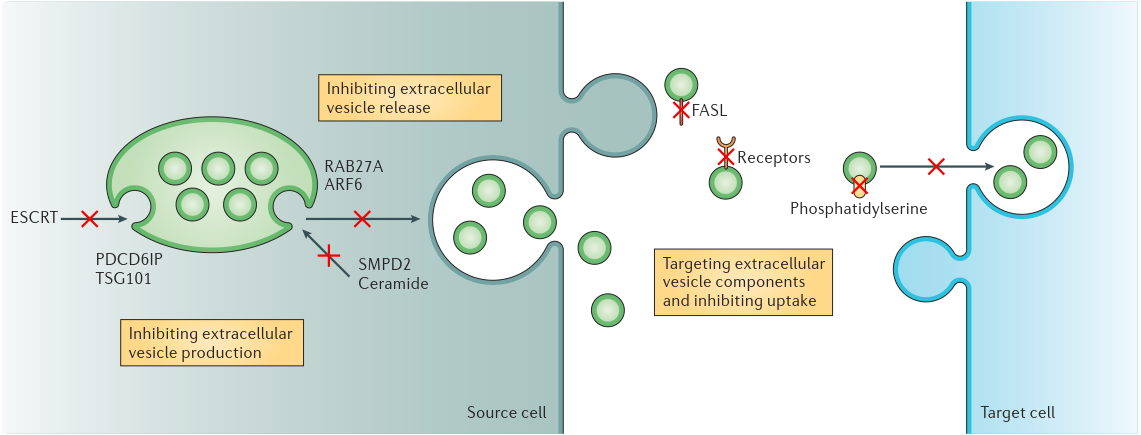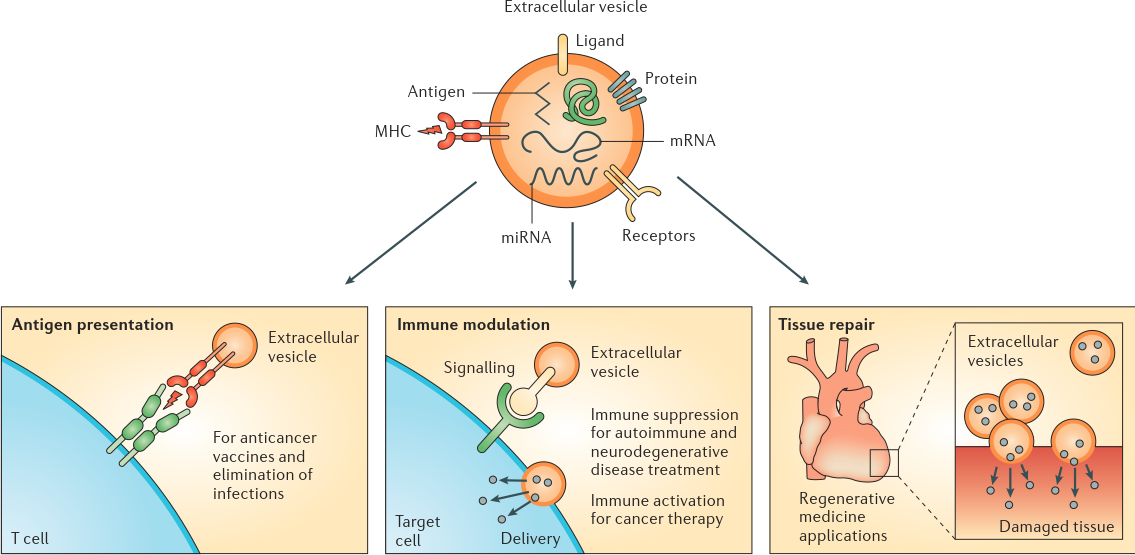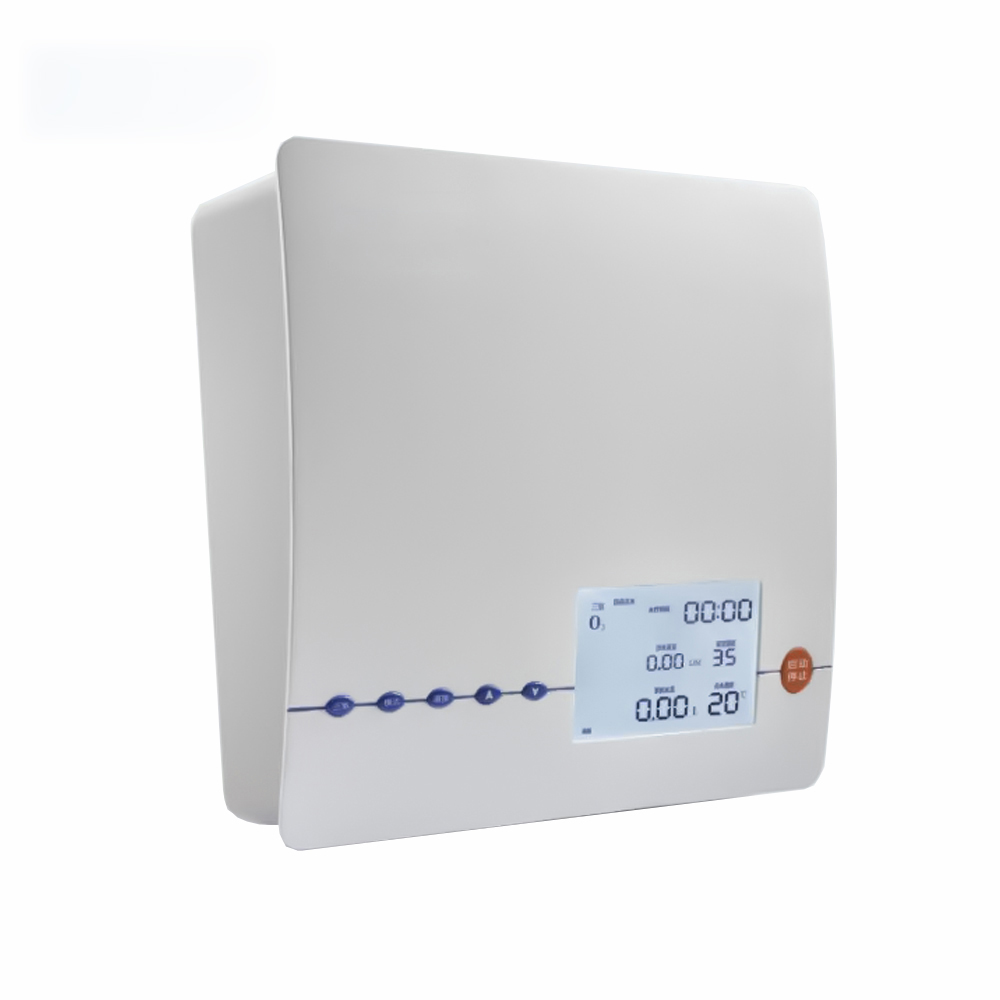Exosomes Quick Pass Manual (Part II - Application)
Last week, we introduced the concept and role of exosomes. This article continues to understand the knowledge of exosomes. I believe that after reading these two articles, everyone can have a deeper understanding of exosomes. 01 Application Given the growing evidence of exosome-mediated pathogenesis, at least four strategies are available for influencing exosomes-driven diseases, involving various aspects of inhibiting exosome function. These strategies include their production, release, cellular uptake or targeting of specific exosomal components that cause disease. Inhibition of exosome-mediated pathogenesis has a prototype correlation in cancer, where exosomes are closely related to many aspects of tumorigenesis and tumor-associated pathology. It has been shown that the level of circulating exosomes increases more than twofold with cancer progression and is associated with survival in melanoma patients. Therefore, therapeutic interventions aimed at reducing the load of circulating exosomes or blocking key components of exosomes are being developed. However, caution is needed at this stage, as most in vitro and in vivo studies have so far been performed using high concentrations of exosomes. The treatment strategy is briefly described below. Inhibition of exosome formation It is known that various cellular components are critical for the formation of exosomes, but specific inhibition strategies are still being developed and their use in disease models has largely been untested. Neutral small molecule inhibitors are used at this stage or by inhibiting ceramide formation by treatment with the hypotensive drug amiloride (usually attenuating endocytic vesicle recycling) (important for endosome sorting and exosome production) Can reduce the production of exosomes. The use of amiloride has been shown to be effective in vivo to reduce the growth of mouse and human tumor cells by blocking the secretion of tumor-derived exosomes containing membrane-associated heat shock protein 72 (HSP72), otherwise it would mediate immunosuppressive effects on myeloid-derived suppressor cells. A recent study showed that syndecan proteoglycans, syntenin, and PDCD6IP regulate exosome formation, and therefore, exosome release can be attenuated by RNA interference (RNAi) or by direct interference with small molecule inhibitors. Alternative methods that have not been tested may be to spatially block specific transmembrane proteins (eg, TSPAN30, CD63). Inhibition of exosomes release Many proteins are involved in the secretion of exosomes, but the exact mechanism by which exosomes are released is still elusive and may not be the same in different cell conditions. In some tumor cells, exosome release is dependent on the GTPase RAB27A and has been shown to be a reasonable therapeutic target (using RNAi) to reduce tumor exosome-mediated signaling to inhibit neutrophils that support tumor growth. . This method reduces the growth rate of primary metastatic cancer and reduces the metastasis of lung tumors in mice. A recent independent study of a mouse model of melanoma in vivo has been confirmed, in which inhibition of RAB27A leads to tumor growth. And the reduction in transfer. Other GTPases such as RAB11 and RAB35 can serve as surrogate targets for inhibiting exosomal release by impairing the docking of multivesiculars with the plasma membrane. Inhibition of exosomal uptake Several exosomes uptake mechanisms have been proposed, but lack detailed information on key steps in exosomal transport and target definition. Nevertheless, the uptake of the outer vesicles released by the tumor cells can be attenuated by blocking the phosphatidylserine of the receptor. In fact, this strategy reduces the growth rate of human glioma xenografts in mice. However, although feasible, the broad applicability of this strategy may be hindered by other limited physiological functions due to its limited specificity. In a non-tumor setting, the effect of HIV-1 on T cells can be attenuated by targeting cell adhesion molecule 1 (ICAM1), which is present on the outer vesicle-wrapped virus, thereby preventing binding to β2 integrin (LFA1). Block specific exosomes Studies have shown that the development of small vesicle small molecule therapy is of great significance. It is important to address the off-target effects that may be caused by interference with outer vesicle production, as exosomes are not only important for normal physiological regulation, but are also important for the production of many extracellular vesicles. The therapeutic potential of MSCs is reflected in an increasing number of ongoing clinical trials for various diseases, including cardiovascular disease, graft versus host disease and Crohn's disease, and acute kidney injury (see ClinicalTrials.gov website). In addition to the several strategies described above, it is also feasible to utilize the properties of the outer vesicles themselves for treatment, for example, therapeutic exosomes, which utilize the biological activity of exosomes to promote tissue regeneration. This is because exosomes are mainly derived from stem cells, which are capable of inducing angiogenesis in resting endothelial cells, inhibiting apoptosis and stimulating cell proliferation, transmitting immune regulatory signals, and collecting or reconstituting cells required for tissue regeneration. In contrast, exosomes from specifically differentiated cell types (immunomodulatory cells) can be utilized to induce or inhibit a specific immune response. The most interesting feature of exosomes for drug delivery, exosomes, may be their ability to transport various RNA species between cells. Early studies from the Ratajczak group identified mRNA in exosomes from embryonic stem cells and cancer cells and showed that they can be transferred to hematopoietic progenitors and monocytes, respectively. Subsequently, in one such study, human mast cell-derived exosomes delivered mRNA expressed in mouse mast cells, and in another study, glioma cells were shown to not only transmit receptor cells but also It is converted to protein, secreted with microvesicles that report mRNA, and subsequently expressed in recipient cells. Importantly, in both studies, a large number of smaller RNA species - especially miRNAs - were detected in the exosomes. Exosomes as therapeutic agents Exosomes for drug delivery 02 Clinical application There is no doubt that exosomes are at the heart of intercellular communication and have therapeutic potential. Although a great deal of research has been carried out in the past in the study of exosome biology, many of the features and mechanisms are still elusive, and there are still many problems that plague the clinical application of exosomes. For example, MSC-derived exosomes have been shown to both inhibit and promote tumor growth. This difference may be the result of differences in cell culture conditions prior to harvesting exosomes, differences in purification protocols used or due to lack of robust exosomal characterization. It is clear that environmental cell culture conditions are affected by the amount of exosomes. In addition, the standardization of exosomes urgently needs improvement. Differential ultracentrifugation has become the gold standard for exosomes purification; however, there are concerns that vesicle production and activity are relatively low, as preclinical and clinical trials will require large-scale, cost-effective and standardized exosome production protocols. At this stage, it is also necessary to fully explore the biology of exosomes and assess potential hazards. The latter include, for example, alleviating the potential harm of therapeutic exosomal metastasis to protocells, unnecessary nucleic acid or protein component transfer, deleterious immune system activation, and the spread of animal viruses prior to clinical application. It has become an important new therapeutic strategy to directly target exosomes to inhibit their removal in mediating diseases, to exploit their inherent potential to stimulate regenerative responses or to transport nucleic acids and other drugs into targets. 03 Market trends 2018.7.19 Clinical stage regenerative medicine company Regeneus announced that the US Patent Office has passed a patent on the use and use of Progenza under the name "Therapeutic Agents Using Fat Cells and Cell Secretions", U.S. Patent Application Serial No. 14/342,479. Progenza is Regeneus' cell therapy technology platform for the treatment of osteoarthritis and other musculoskeletal disorders. It may be used to treat other inflammatory diseases that currently lack treatment. 2018.7.16 BioTourage Company NeuroTrauma Sciences, LLC (NTS) and the non-profit organization Henry Ford Health System announced that the newly established NTS subsidiary has received years of research sponsorship and licensing agreements. The new company, called NeuroExo Sciences, LLC (NXS), aims to advance Henry Ford's pioneering technology, which involves exosomes as microRNA-rich extracellular vesicles for the treatment of stroke and traumatic brain injury (TBI). , including concussion and neuropathy. 2018.7.24 PureTech Health plc is a clinical-stage biopharmaceutical company that develops new drugs for the Brain-Immune-Gut (BIG) axis, today announced with F. Hoffmann-La Roche Ltd and Hoffmann- La Roche Inc has worked for many years to advance PureTech's milk-derived exosome platform technology for oral Roche antisense oligonucleotide platforms. 2018.9.7 ExoCoBio, based in South Korea, published a scientific paper on stem cell-derived exosomes in Stem Cell Research and Therapy, which significantly attenuated atopic dermatitis and inhibited multiple inflammatory targets. 2018.9.7 Evox Therapeutics, a British exogenous treatment application development company, today announced that it has raised £35.5 million ($45.4 million) in Series B financing. Evox is designing exosomes (the body's natural vesicle delivery system) to enable various drugs (proteins, small molecules, and nucleic acids) to reach previously inaccessible tissues, such as transporting drugs to the central nervous system through the blood-brain barrier, Intracellular delivery of biological agents, as well as delivery of liver RNA therapeutic drugs. 2018.10.13 NanoView Biosciences, an emerging leader in the field of exosome detection and characterization, today announced the completion of a $10 million Series B round of financing led by Northpond Ventures. 2018.10.31 NX Prenatal announced the introduction of exogenous preterm birth risk testing into clinical validation. 2019.1.30 Avalon and its subsidiary Genexosome: The world's first salivary exosome-based biomarker miR-185 serves as a dual target for the diagnosis and treatment of oral cancer. 2019.3.26 The latest report from GBI Research - Exosome Technology: Recently, the main participants Capricor, Codiak and Evox Therapeutics explored the application of exosome technology in the pharmaceutical and healthcare industries. The size of the exogenous industry is expected to reach $2.28 billion in 2030.
Colon Hydrotherapy Machine Principle:
The Colon Hydrotherapy Machine adopts the non-intrusive method to provide a safe and comfortable therapy, and it can operated easily; the user only need to hold the are-shape hydrotherapy nozzle and put it on the anus gently, the treated pure water with constant temperature and pressure will flow into the colon from the anus.
Colon Hydrotherapy Machine Function: Colon Hydrotherapy Machine,Colon Hydrotherapy,Portable Colon Hydrotherapy Machine,Colon Hydrotherapy Equipment Shenzhen Guangyang Zhongkang Technology Co., Ltd. , https://www.szlighttherapymachine.com
Exosomes as therapeutic targets 

a lubricant layer between the intestinal wall and feces forms soon after water enters the colon; then the impacted feces and toxins will be evacuated through natural excretion mechanisms by decomposing the impacted feces, and promoting the squirm of large intestine.
The process enables a quick and thorough defecation. It is completely painless, non-toxic and free of side effects. Besides, the ozone generator in the system can provide ozone water for gynecologic and skin sterilization.

Get rid of constipation: colon hydrotherapy system will dissolve and dilute impacted feces, and stimulate the natural defecation function. Eliminate impacted feces and toxins: colon hydrotherapy system adopts physical method to clean out the impacted feces and toxins, thus it will reduce risk of
[autointoxication".
There`re not only the residues of digested food but also a lot of toxins, such as ammonia which may induce hepatic coma, hydrogen sulfide affecting the nervous system, methylindole leading to cancer, botulinum toxin, Tan toxic alkali, benzene, formic acid, butyric acid and so on. With the growing age, feces and toxins gradually accumulate in the body;
Been absorbed into the blood system by the intestinal mucosa, they will cause damage to the organs, meanwhile, lead to digestive system diseases and skin problems, even though make blood pressure problem, heart disease, Alzheimer`s and other symptoms worse. Impacted feces accumulate in the colon for a long time is an important inducement to the colorectal cancer.
Gynecologic and skin sterilization: colon hydrotherapy system (except comfort type) has ozone generator to produce ozone water for sterilization of harmful bacteria. Except for removing surface skin bacteria, it can also used for killing harmful bacteria which may cause gynecological inflammation, so it can be used for the treatment of vulva inflammation.
